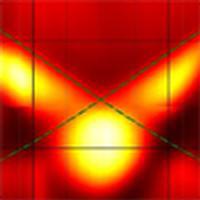Our official English website, www.x-mol.net, welcomes your
feedback! (Note: you will need to create a separate account there.)
Magnetoplasmonic quasicrystals: an approach for multiband magneto-optical response
Optica ( IF 8.4 ) Pub Date : 2018-05-15 , DOI: 10.1364/optica.5.000617 Andrey N. Kalish , Roman S. Komarov , Mikhail A. Kozhaev , Venu Gopal Achanta , Sarkis A. Dagesyan , Alexander N. Shaposhnikov , Anatoly R. Prokopov , Vladimir N. Berzhansky , Anatoly K. Zvezdin , Vladimir I. Belotelov
Optica ( IF 8.4 ) Pub Date : 2018-05-15 , DOI: 10.1364/optica.5.000617 Andrey N. Kalish , Roman S. Komarov , Mikhail A. Kozhaev , Venu Gopal Achanta , Sarkis A. Dagesyan , Alexander N. Shaposhnikov , Anatoly R. Prokopov , Vladimir N. Berzhansky , Anatoly K. Zvezdin , Vladimir I. Belotelov

|
Nanostructured magneto-optical materials that sustain optical resonances provide an efficient way to control light via the magnetic field, which is of prime importance for telecommunication and sensing applications. However, their response is usually narrowband due to their resonance character. Here, we demonstrate and investigate a type of magnetoplasmonic structure, or quasicrystal, that demonstrates a unique magneto-optical response. It consists of a magnetic dielectric film covered by a thin gold layer perforated by slits, forming a Fibonacci-like binary sequence. The transverse magneto-optical Kerr effect (TMOKE) acquires controllable multiple plasmon-related resonances, resulting in a magneto-optical response over a wide frequency range. In particular, for the experimentally studied samples, the TMOKE resonances are observed in the wavelength range from to . Multiband TMOKE is valuable for numerous nanophotonic applications, including optical sensing, control of light, all-optical control of magnetization, etc. TMOKE spectroscopy is also an efficient tool for investigating the peculiarities of plasmonic quasicrystals.
中文翻译:

磁等离子体准晶体:一种多频带磁光响应的方法
维持光学共振的纳米结构磁光材料提供了一种通过磁场控制光的有效方法,这对于电信和传感应用至关重要。但是,由于它们的共振特性,它们的响应通常是窄带的。在这里,我们演示并研究了一种磁等离子体结构或准晶体,该结构展示了独特的磁光响应。它由一层覆盖有狭缝的薄金层覆盖的磁性电介质膜组成,形成类似斐波那契的二元序列。横向磁光克尔效应(TMOKE)获得可控的多个与等离子体激元相关的共振,从而在较宽的频率范围内产生磁光响应。特别是对于实验研究的样品, 到 。多波段TMOKE在许多纳米光子应用中都很有价值,包括光学传感,光控制,磁化全光控制等。TMOKE光谱也是研究等离激元准晶体特性的有效工具。
更新日期:2018-05-18
中文翻译:

磁等离子体准晶体:一种多频带磁光响应的方法
维持光学共振的纳米结构磁光材料提供了一种通过磁场控制光的有效方法,这对于电信和传感应用至关重要。但是,由于它们的共振特性,它们的响应通常是窄带的。在这里,我们演示并研究了一种磁等离子体结构或准晶体,该结构展示了独特的磁光响应。它由一层覆盖有狭缝的薄金层覆盖的磁性电介质膜组成,形成类似斐波那契的二元序列。横向磁光克尔效应(TMOKE)获得可控的多个与等离子体激元相关的共振,从而在较宽的频率范围内产生磁光响应。特别是对于实验研究的样品, 到 。多波段TMOKE在许多纳米光子应用中都很有价值,包括光学传感,光控制,磁化全光控制等。TMOKE光谱也是研究等离激元准晶体特性的有效工具。











































 京公网安备 11010802027423号
京公网安备 11010802027423号